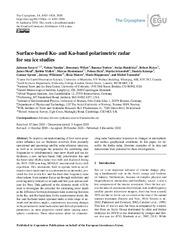Surface-based Ku-and Ka-band polarimetric radar for sea ice studies
Permanent lenke
https://hdl.handle.net/10037/23342Dato
2020-12-04Type
Journal articleTidsskriftartikkel
Peer reviewed
Forfatter
Stroeve, Julienne C.; Nandan, Vishnu; Willatt, Rosemary; Tonboe, Rasmus; Hendricks, Stefan; Ricker, Robert; Mead, James; Mallett, Robbie; Huntemann, Marcus; Itkin, Polona; Schneebeli, Martin; Krampe, Daniela; Spreen, Gunnar; Wilkinson, Jeremy; Matero, Ilkka; Hoppmann, Mario; Tsamados, MichelSammendrag
To improve our understanding of how snow properties influence sea ice thickness retrievals from presently
operational and upcoming satellite radar altimeter missions,
as well as to investigate the potential for combining dual
frequencies to simultaneously map snow depth and sea ice
thickness, a new, surface-based, fully polarimetric Ku- and
Ka-band radar (KuKa radar) was built and deployed during
the 2019–2020 year-long MOSAiC international Arctic drift
expedition. This instrument, built to operate both as an altimeter (stare mode) and as a scatterometer (scan mode), provided the first in situ Ku- and Ka-band dual-frequency radar
observations from autumn freeze-up through midwinter and
covering newly formed ice in leads and first-year and secondyear ice floes. Data gathered in the altimeter mode will be
used to investigate the potential for estimating snow depth
as the difference between dominant radar scattering horizons
in the Ka- and Ku-band data. In the scatterometer mode, the
Ku- and Ka-band radars operated under a wide range of azimuth and incidence angles, continuously assessing changes
in the polarimetric radar backscatter and derived polarimetric
parameters, as snow properties varied under varying atmospheric conditions. These observations allow for characterizing radar backscatter responses to changes in atmospheric
and surface geophysical conditions. In this paper, we describe the KuKa radar, illustrate examples of its data and
demonstrate their potential for these investigations.
Forlag
Copernicus PublicationsSitering
Stroeve, Nandan, Willatt, Tonboe, Hendricks, Ricker, Mead, Mallett, Huntemann, Itkin P, Schneebeli, Krampe, Spreen, Wilkinson, Matero, Hoppmann, Tsamados. Surface-based Ku-and Ka-band polarimetric radar for sea ice studies. The Cryosphere. 2020;14(12):4405-4426Metadata
Vis full innførselSamlinger
Copyright 2020 The Author(s)


 English
English norsk
norsk